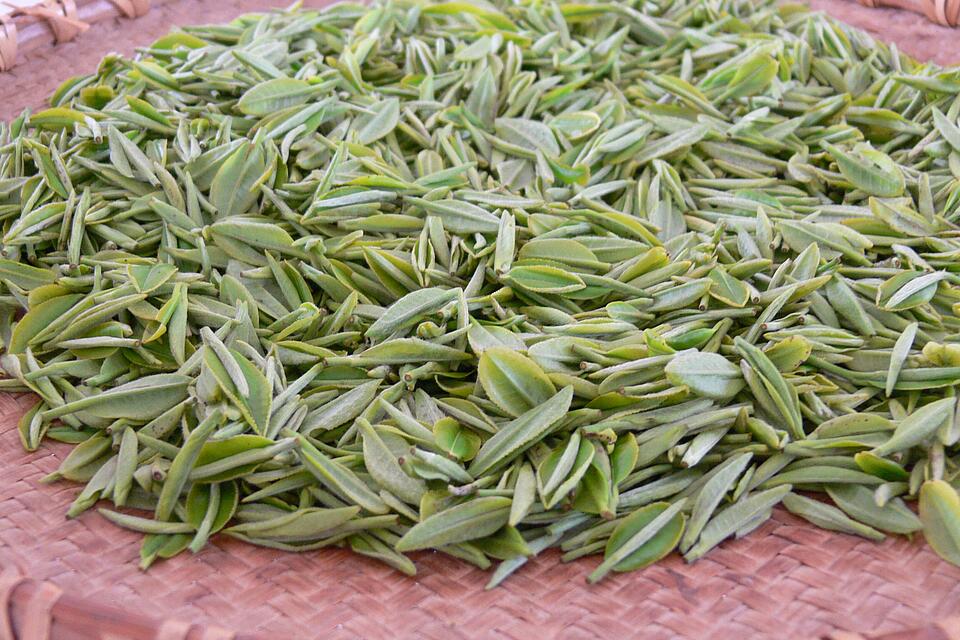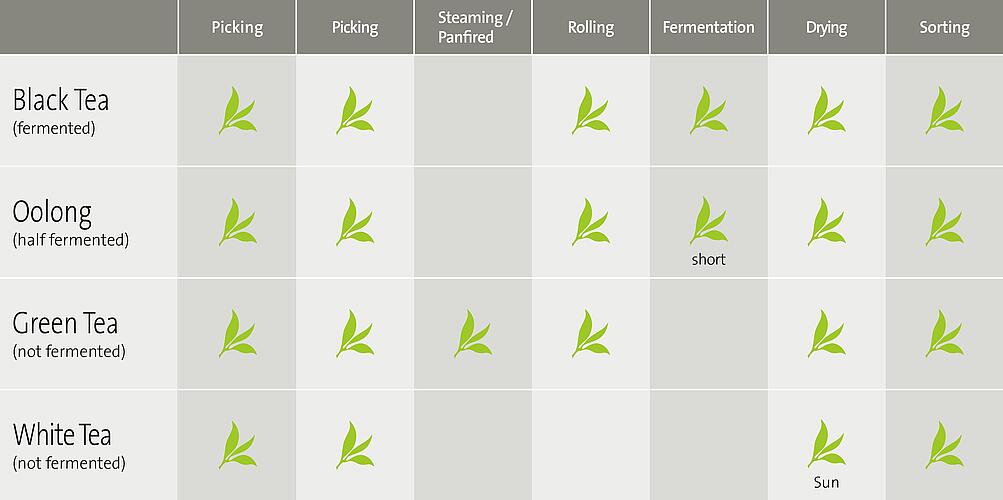
Tea Production
From the plant to enjoyment
Only the young leaves of the “Thea Sinensis” and “Thea Assamica” tea plants and their varieties are used for black, green and white tea:
Thea Sinensis (or Chinese tea) is a shrub-like plant which reaches a maximum height of 3-4 m and can even survive frost. Thea Assamica (or Assam tea) is a tall, stately tree that raises to a height of 15-20 m and only grows in tropical regions.
For tea production, both varieties are pruned to waist height. The continuous hybridisation of these two original plants forms the basis of all tea cultures in the world today. The typical character of black, green and white tea arises from the different methods used to process the fresh tea leaves.

Terms and Definitions
Picking – In the provenance “Two leaves and a bud” are picked. Meaning the two first emerging leaves and the bud.
Withering – By withering the leaves get smooth in order to prevent uncontrolled breaking during production. The process is mainly carried out on special withering tubs.
Steaming – The leaves are treated or steamed in pans to prevent from fermentation.
Rolling – By rolling the cell walls burst and cytosol discharges. The cytosol reacts with the oxygen of the ambient air and initiates the fermentation. Rolling is also relevant for the shape of the leave.
Fermentation – The reaction of the cytosol with oxygen results in fermentation, an oxidation process, whereby the colour of the leaves turn from green into red and thus to a darker colour of the tea.
Drying – The drying causes the cytosol to attach itself to the leaf. The complete leaf dries and turns dark.
Sorting – In order to separate the leaf sizes and to divide them into different leaf grades, large mechanical vibrating screens are used for sorting.
Specifics
Green Tea – By heating before rolling the activity of the enzymes is stopped and the fermentation fails.
White Tea – White Tea is dried on a large area in the sun directly after withering. This avoids the fermentation as well.
Oolong – Compared to Black Tea the fermentation is stopped by the premature termination of the drying.
Classification
Leaf Grades at a glance
The differences between tea in all its facets emerge from the processing traditions, climatic conditions in the regions, classifications and the tea estate name. While in the case of green tea, the type of preparation (steamed or pan-fired) and the standard name says it is decisive, black teas are distinguished by abbreviations used for describing the leaf quality.
Main leaf grades for Black Tea
OP – Orange Pekoe
Quality indicator for black tea with whole, medium-sized leaves.
FOP – Flowery Orange Pekoe
Tea made from delicate, young leaves, abundance of tips.
GFOP – Golden Flowery Orange Pekoe
Exquisite tea with light, golden tips.
TGFOP – Tippy Golden Flowery Orange Pekoe
Very high proportion of fine, golden tips - mainly Assam.
FTGFOP – Finest Tippy Golden Flowery Orange Pekoe
Carefully selected, extremely fine and even leaves with many tips - mainly Darjeeling.
BOP – Broken Orange Pekoe
The word “broken” means that the leaves are broken during the rolling process. All other leaf grades with “B” generally denote broken teas, i.e. made with “broken” tea leaves.
1 – The number 1 following the letters indicates the highest quality within a group.
Differentiations in Green Tea
Steaming – With this method, which originated in Japan, the fresh tea leaves are exposed to hot steam, thus preventing fermentation.
The tea often has a fresh, grassy note. Examples of Japanese teas: Gyokuro, Matcha
Pan fired Tea – In China, the fresh tea leaves are briefly roasted in a hot pan, which gives the tea a slightly tart smoky note.
Examples of Chinese teas: Gunpowder, Chun Mee
